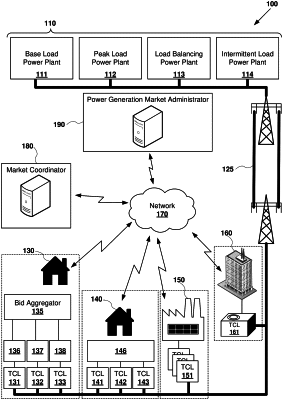| CPC G06Q 50/06 (2013.01) [G05B 13/041 (2013.01); G06N 7/01 (2023.01); G06Q 30/08 (2013.01); G06Q 40/04 (2013.01); H02J 3/008 (2013.01); H02J 3/14 (2013.01); H02J 13/00017 (2020.01); H02J 13/00034 (2020.01); H02J 3/00 (2013.01); H02J 2310/64 (2020.01); Y02B 70/3225 (2013.01); Y04S 10/50 (2013.01); Y04S 20/222 (2013.01); Y04S 50/10 (2013.01)] | 20 Claims |

|
1. A method comprising:
determining an energy response function characterized by a parameter vector, the energy response function relating price data for one or more energy prices to quantity data for power to be consumed by a thermostatically controlled load, the load being one of a plurality of thermostatically controlled loads situated to receive power from a power grid;
sending the parameter vector as a bid for power for a finite time period based on the energy response function to a coordinator;
responsive to the sending of the parameter vector, receiving a clearing price from the coordinator; and
responsive to the receiving of the clearing price, sending a signal to cause actuation of the load during the finite time period,
the energy response function being based at least in part on a hybrid state of the load and a user response parameter relating energy price and a selected user comfort level, and
the hybrid state of an ith load of the plurality of thermostatically controlled loads being defined as xi(t)=[qi(t), zi(t)]T, in which qi(t) represents a control policy for the ith load, zi(t) represents a continuous state of the ith load, and T represents a length of a market clearing cycle.
|